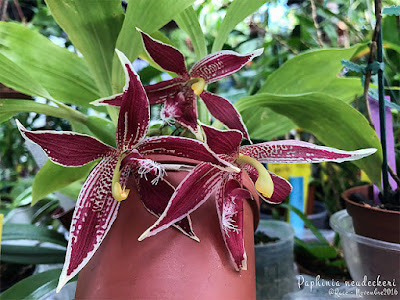Paphinia neudeckeri is found in Colombia, Ecuador and Peru. It is found in the mountain forests with warm and humid climate, at an altitude of 750-1300 meters...
Paphinia neudeckeri also called as Neudecker's Paphinia, Paphinia neudeckeri f. mocoaensis, Paphinia neudeckeri var. mocoaensis, is a species of the genus Paphinia. This species was described by Rudolf Jenny in 1983.
IDENTIFY PAPHINIA NEUDECKERI
Paphinia neudeckeri is found in Colombia, Ecuador and Peru. It is found in the mountain forests with warm and humid climate, at an altitude of 750-1300 meters.
It is a small sized, warm to cool growing, caespitose epiphyte with an oblong, tapered, lightly complanate, 4 cm long pseudobulb enveloped below by a few, imbricate acute, lower leafless, upper leaf-bearing sheaths with 2, apical, oblanceolate, attenuate, acute, thin, ribbed, deciduous, 25 cm long leaves.
Neudecker's Paphinia blooms in the summer on a basal, 4 cm long, laxly pendant, 2 to 4 flowered raceme with 2 to 3 close, ovate-triangular bracts and a single triangular floral bract carrying fragrant flowers and arises with a new growth. The flowers are up to 12 cm in diameter.
PAPHINIA NEUDECKERI CARE AND CULTURE
Cultural information should only be used as a guide, and should be to be adapted to suit you. Your physical location; where you grow your plants, how much time you have to devote to their care, and many other factors, will need to be taken into account. Only then can you decide on the cultural methods that best suit you and your plants.
Light:
Paphinia neudeckeri needs a light level of 12000-18000 lux, with the 12-hour photoperiod. It should never be exposed to direct sunlight: it will be impossible to avoid burns on the leaves.
Temperature:
It is a warm thermal requirements species. The ideal temperatures are 26-27 ° C during the day and 17-18 ° C at night throughout the year.
Humidity:
Neudecker's Paphinia needs the average humidity of 80-88% throughout the year.
Substrate, growing media and repotting:
The inflorescences of Paphinia neudeckeri develop from the base of the pseudobulbs and are pending; so its cultivation in a classic vase is quite complicated. I would recommend using the basket or mounting it on a raft. Medium-sized bark with a coarse fiber sphagnum (in proportion 2: 1), or coarse fiber sphagnum with perlite (proportion 1: 1) is used as a substrate, although the latter is impractical when it comes to of a basketball. If you choose to mount it on a raft, it is advisable to put a little sphagnum on its roots to prevent dehydration. By placing this orchid in the basket, it is important to put it on top of the substrate, to prevent the inflorescences from trapping inside the substrate during their growth.
Watering:
The cultivated plant needs frequent watering: the substrate must never become completely dry. Beware of stagnant water: if they happen, they can cause radical rots.
Fertilizer:
It is fertilized with 1/4 of the indicated dose on the bottle of a suitable liquid fertilizer for orchids. The fertilizations take place once every 3-4 watering (but no more often than once every 10 days). Before fertilizing the plant it is important to water it, to avoid the harmful contact of the fertilizer with the dry roots.
Rest period:
Paphinia neudeckeri does not needs a rest period. The conditions of cultivation must remain stable throughout the year.















COMMENTS